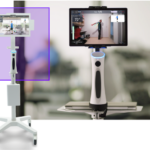Discover how computer vision-based AI enhances physical therapy by improving treatment accuracy, patient engagement, and recovery outcomes, making care more effective and efficient.
Introduction
In recent years, advances in technology have revolutionized healthcare, and physical therapy is no exception. One of the most exciting innovations is the integration of computer vision-based AI into physical therapy clinics. This cutting-edge technology provides real-time analysis of movement patterns, enhances treatment precision, and allows patients to engage more actively in their rehabilitation process.
At Victory Physical Therapy, we’ve embraced computer vision-based AI to elevate patient care, improve outcomes, and make therapy more engaging. In this article, we’ll explore how computer vision-based AI benefits physical therapy patients and transforms the recovery experience.
What is Computer Vision-Based AI in Physical Therapy?
Computer vision-based AI uses advanced algorithms to analyze and interpret movement patterns through video data. By capturing a patient’s movement, the AI can assess their range of motion, posture, and mechanics in real-time. This data helps physical therapists design more precise and effective treatment plans based on objective metrics, providing deeper insights into a patient’s condition than traditional observation alone.
1. Improved Accuracy and Precision in Treatment
One of the most significant benefits of integrating computer vision-based AI into physical therapy is the increased accuracy it brings to assessments and treatments. Traditionally, physical therapists rely on visual assessments and manual measurements, which, while effective, can be subject to human error. With computer vision, therapists can analyze a patient’s movement with exact precision.
Here’s how this benefits patients:
- Objective Data: The AI system provides detailed measurements of a patient’s joint angles, movement patterns, and range of motion, which helps therapists identify even the smallest deviations from normal movement. This leads to more accurate diagnoses and more personalized treatment plans.
- Precise Progress Tracking: By using real-time data, therapists can track a patient’s progress with measurable accuracy. This allows for adjustments to be made quickly if the patient is not improving as expected, ensuring faster and more effective recovery.
- Reduced Risk of Re-Injury: The precision of AI analysis helps identify potential movement issues early, allowing therapists to address and correct improper mechanics before they lead to injury or re-injury.
With computer vision-based AI, patients receive highly individualized care tailored to their exact needs, improving overall treatment outcomes.
2. Enhanced Patient Engagement and Motivation
Engaging patients in their physical therapy journey is crucial for successful outcomes, and computer vision-based AI helps make rehabilitation more interactive and motivating. The technology allows patients to see their own progress in real-time, making therapy more tangible and rewarding.
Here’s how this enhances patient engagement:
- Visual Feedback: Patients can view real-time visual representations of their movements and see how they align with the target movements recommended by their therapist. This immediate feedback helps patients understand their progress and what needs improvement.
- Gamified Therapy: Some AI-based systems integrate gamification elements, where patients can earn points or reach milestones based on their performance. This turns rehabilitation into an engaging and motivating process, making patients more likely to stick to their treatment plan.
- Increased Accountability: By having access to real-time data, patients are more aware of their progress (or lack thereof), encouraging them to take an active role in their recovery and adhere to prescribed exercises.
When patients can see the immediate impact of their efforts, they’re more likely to stay committed, which leads to better long-term results.
3. Faster and More Efficient Recovery
The use of computer vision-based AI allows for a more streamlined and efficient approach to physical therapy, meaning patients can experience faster recovery times.
Here’s how this leads to improved recovery outcomes:
- Optimized Treatment Plans: By providing highly detailed data on a patient’s movement patterns, AI allows therapists to design treatment plans that target the specific areas of dysfunction. This eliminates guesswork and ensures that each exercise and intervention directly addresses the patient’s needs.
- Early Detection of Progress Plateaus: AI’s real-time tracking capabilities mean that therapists can quickly identify when a patient’s progress has plateaued. This allows them to adjust the treatment plan, introducing new exercises or modifications that challenge the patient and keep them on the path to recovery.
- Efficient Use of Time: Because AI provides immediate feedback and insights, both patients and therapists can make the most of their therapy sessions. Therapists can spend more time on direct interventions and less time on manual assessments, making each session more productive.
By enhancing the accuracy and efficiency of treatment, computer vision-based AI helps patients recover more quickly and effectively.
4. Personalized Care and Long-Term Results
Every patient’s body is different, and computer vision-based AI allows for a truly personalized approach to physical therapy. The technology’s ability to track individual progress and provide data-driven insights ensures that each patient receives care that’s tailored to their unique needs.
Here’s how personalized care benefits patients:
- Tailored Exercises: With AI tracking their performance, patients receive exercise programs that are specifically designed to address their weaknesses and movement limitations. As they progress, the AI can adapt the program to keep it aligned with their current abilities.
- Ongoing Monitoring: Even after patients have completed their in-clinic treatment, computer vision-based AI systems can continue to track their progress remotely. This allows therapists to provide follow-up care, ensuring long-term recovery and preventing future injuries.
- Injury Prevention: With precise monitoring and analysis, therapists can spot imbalances or improper movement patterns that may lead to injury in the future. By addressing these early, patients can avoid further complications, leading to better long-term health outcomes.
This personalized, data-driven approach ensures that patients not only recover but also build a foundation for long-term health and injury prevention.
5. Empowering Patients Through Data
Another unique benefit of computer vision-based AI is its ability to empower patients with data. Many patients want to understand their progress in concrete terms, and the detailed insights provided by AI allow them to take control of their recovery.
Here’s how AI empowers patients:
- Objective Progress Tracking: Patients can see measurable data on how far they’ve come since starting therapy. This can boost motivation and reinforce the importance of their efforts, as they can see their improvement in real numbers.
- Self-Management Tools: Some computer vision systems come with self-management apps, allowing patients to continue their exercises at home while the AI monitors their form and provides feedback. This extends the benefits of therapy beyond the clinic, giving patients more control over their recovery.
- Confidence Building: By giving patients clear, real-time insights into their improvement, AI technology builds confidence that they are on the right path. This sense of ownership over their recovery fosters better adherence to the rehabilitation program and increases the likelihood of successful outcomes.
At Victory Physical Therapy, we believe that empowering patients with information is key to long-term success. Computer vision-based AI helps us provide that information in a clear, understandable, and actionable way.
Conclusion: A New Era of Physical Therapy with Computer Vision-Based AI
The integration of computer vision-based AI in physical therapy represents a significant leap forward in how care is delivered. By improving accuracy, enhancing patient engagement, and providing a personalized approach, this technology helps patients recover faster, stay motivated, and achieve long-term success.
At Victory Physical Therapy, we’re proud to be at the forefront of this exciting innovation. Our commitment to using the latest technology ensures that our patients receive the best possible care, helping them not only recover but come back stronger than ever.
Ready to experience the future of physical therapy? Contact us today to learn how our cutting-edge approach can help you achieve your recovery goals.
Call to Action: Call us at 503-693-8105 or visit Victory Physical Therapy to schedule your appointment and discover how computer vision-based AI can transform your physical therapy experience.













